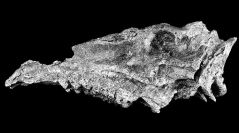

 Geodiversitas
25 (2) - Pages 347-404
Geodiversitas
25 (2) - Pages 347-404Newly collected listriodont suid fossils from Spanish deposits assigned to zones MN4, MN5 and MN7 and from France (MN4 to MN7) reveal a great deal about these Suiformes and indicate that a revision of their systematics and phylogeny is necessary. One new species of Listriodon von Meyer, 1846, Listriodon retamaensis n. sp., is described, and descriptions of craniodental specimens of other species (Listriodon lockharti Pomel, 1848 and Listriodon splendens von Meyer, 1846) are provided. There are two distinct cranial and postcranial morphotypes among European listriodonts: Eurolistriodon Pickford & Moya Sola, 1995, in which the postcranial bones are elongated and gracile and the snout is adorned with large laterally oriented horn-like processes above the canine; and Listriodon, in which the postcranial bones are short and robust, and in which the canine flange is not as marked. The dental morphology of primitive listriodonts, including both Eurolistriodon and Listriodon, suggests that the subfamily was derived from a hyothere similar to Hyotherium meisneri von Meyer, 1850 or a similar species. The chronological and geographic distribution of listriodonts in Africa and Eurasia is examined. It is confirmed that Kubanochoerinae do not belong to the same subfamily as listriodonts.
Mammalia, Suidae, Listriodontinae, Old World, biogeography, biostratigraphy, new species